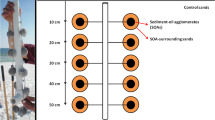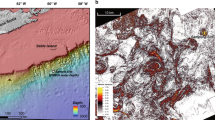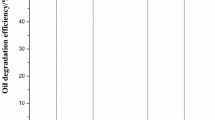Abstract
The nature, activity and metabolism of microbes that inhabit the deep subsurface environment are a matter of ongoing debate1,2,3,4,5,6,7. Primarily limited by temperature8, little is known about secondary factors that restrict or enhance microbial activity9,10 or about the extent of a habitable environment deep below the surface. In particular, the degraders of chemically inert organic substrates remain elusive9. Petroleum reservoirs can be regarded as natural bioreactors and are ideally suited for the study of microbial metabolism in the deep subsurface. Here we analyse series of oil samples that were biodegraded to different degrees. We find fatty acids after hydrolysis of purified crude oil fractions, indicating the presence of intact phospholipids and suggesting that indigenous bacteria inhabit petroleum reservoirs in sediment depths of up to 2,000 m. A major change in bacterial community structure occurs after the removal of n-alkanes, indicating that more than one consortium is responsible for petroleum degradation11. Our results suggest that further study of petroleum fluids will help understand bacterial metabolism and diversity in this habitat of the deep subsurface.
This is a preview of subscription content, access via your institution
Access options
Subscribe to this journal
Receive 12 print issues and online access
$259.00 per year
only $21.58 per issue
Buy this article
- Purchase on Springer Link
- Instant access to full article PDF
Prices may be subject to local taxes which are calculated during checkout



Similar content being viewed by others
References
Schippers, A. et al. Prokaryotic cells of the deep sub-seafloor biosphere identified as living bacteria. Nature 433, 861–864 (2005).
Jørgensen, B. B. & D’Hondt, S. Science 314, 932–934 (2006).
Parkes, R. J. et al. Temperature activation of organic matter and minerals during burial has the potential to sustain the deep biosphere over geological timescales. Org. Geochem. 38, 845–852 (2007).
Aitken, C. M., Jones, D. M. & Larter, S. R. Anaerobic hydrocarbon biodegradation in deep subsurface oil reservoirs. Nature 431, 291–294 (2004).
Parkes, R. J. et al. Deep sub-seafloor prokaryotes stimulated at interfaces over geological time. Nature 436, 390–394 (2005).
De Long, E. F. Science 306, 2198–2200 (2004).
Rueter, P. et al. Anaerobic oxidation of hydrocarbons in crude oil by new types of sulphate-reducing bacteria. Nature 372, 455–458 (1994).
Wilhelms, A. et al. Biodegradation of oil in uplifted basins prevented by deep-burial sterilization. Nature 411, 1034–1037 (2001).
Head, I. M., Jones, D. M. & Larter, S. R. Biological activity in the deep subsurface and the origin of heavy oil. Nature 426, 344–352 (2003).
Roeling, W. F. M., Head, I. M. & Larter, S. R. The microbiology of hydrocarbon degradation in subsurface petroleum reservoirs: Perspectives and prospects. Res. Microbiol. 154, 321–328 (2003).
Peters, K. E. & Moldowan, J. M. The Biomarker Guide (Prentice Hall, London, 1993).
Jones, D. M. et al. Crude-oil biodegradation via methanogenesis in subsurface petroleum reservoirs. Nature 451, 176–181 (2008).
Kashefi, K. & Lovley, D. R. Extending the upper temperature limit for life. Science 301, 934–934 (2003).
Lappin-Scott, H. M. & Costerton, J. W. Starvation and penetration of bacteria in soils and rocks. Experientia 46, 807–812 (1990).
Jones, D. M., Watson, J. S., Meredith, W., Chen, M. & Bennett, B. Determination of acids in crude oils using nonaqueous ion exchange solid-phase extraction. Anal. Chem. 73, 703–707 (2001).
Wardroper, A. M. L. et al. Crude oil biodegradation under simulated and natural conditions—II. Aromatic steroid hydrocarbons. Org. Geochem. 6, 605–617 (1984).
Harry, M., Gambier, B., Bourezqui, Y. & Garnier-Sillam, E. Evaluation of purification procedures for DNA extracted from organic rich samples: Interference with humic substances. Analusis 27, 439–442 (1999).
Madigan, M. & Martinko, J. Brock Biology of Microorganisms 11th edn (Prentice Hall, London, 2005).
White, D. C., Davis, W. M., Nickels, J. S., King, J. D. & Bobbie, R. J. Determination of the sedimentary microbial biomass by extractable lipid phosphate. Oecologia 40, 51–62 (1979).
Vestal, J. R. & White, D. C. Lipid analysis in microbial ecology—quantitative approaches to the study of microbial communities. Bioscience 39, 535–541 (1989).
Yao, H., Bowman, D. & Shi, W. Soil microbial community structure and diversity in a turfgrass chronosequence: Land-use change versus turfgrass management. Appl. Soil Ecol. 34, 209–218 (2006).
Green, C. T. & Scow, K. M. Analysis of phospholipid fatty acids (PLFA) to characterize microbial communities in aquifers. Hydrogeol. J. 8, 126–141 (2000).
Bossio, D. A. & Scow, K. M. Impacts of carbon and flooding on soil microbial communities: Phospholipid fatty acid profiles and substrate utilization patterns. Microbiol. Ecol. 35, 265–278 (1998).
Li, Y.-L., Peacock, A. D., White, D. C., Geyer, R. & Zhang, C. L. Spatial patterns of bacterial signature biomarkers in marine sediments of the Gulf of Mexico. Chem. Geol. 238, 168–179 (2007).
Chang, Y. J. et al. Diversity and characterization of sulfate-reducing bacteria in groundwater at a uranium mill tailings site. Appl. Environ. Microbiol. 67, 3149–3160 (2001).
Ollivier, B. & Cayol, J.-L. in Petroleum Microbiology (eds Ollivier, B. & Magot, M.) 71–88 (ASM Press, Washington, 2005).
Voordouw, G. et al. Characterisation of 16S rRNA genes from oil field microbial communities indicates the presence of a variety of sulfate-reducing, fermentative, and sulfide-oxidising bacteria. Appl. Environ. Microbiol. 62, 1623–1629 (1996).
Teske, A. B. Microbial communities of deep marine subsurface sediments: Molecular and cultivation surveys. Geomicrobiol. J. 23, 357–368 (2006).
Bekins, B. A., Godsy, E. M. & Warren, E. Distribution of microbial physiologic types in an aquifer contaminated by crude oil. Microbiol. Ecol. 37, 263–275 (1999).
Gieg, L. M. & Suflita, J. M. Detection of anaerobic metabolites of saturated and aromatic hydrocarbons in petroleum-contaminated aquifers. Environ. Sci. Technol. 36, 3755–3762 (2002).
Acknowledgements
P. Greenwood is thanked for discussions on methods. O. Paech, H. Cieszynski, G. Wiesenberg, B. Stapper, E. Lehndorff, N. Juraschek, and L. Luhrenberg are thanked for discussions. This research was supported by the University of Cologne, a Curtin University International Research Tuition Scholarship and PhD stipend award (C.H.), a travel scholarship from the European Association of Organic Geochemists (C.H.) and a grant-in-aid from the American Association of Petroleum Geologists (C.H.). K.G. acknowledges support from the Australian Research Council for a QEII fellowship.
Author information
Authors and Affiliations
Contributions
C.H. and K.G. designed experiments. C.H. carried out experiments. C.H. and L.S. interpreted results. C.H. wrote the paper. L.S. provided samples and analytical facilities.
Corresponding author
Supplementary information
Supplementary Information
Supplementary figures S1-S4 and table S1 (PDF 1269 kb)
Rights and permissions
About this article
Cite this article
Hallmann, C., Schwark, L. & Grice, K. Community dynamics of anaerobic bacteria in deep petroleum reservoirs. Nature Geosci 1, 588–591 (2008). https://doi.org/10.1038/ngeo260
Received:
Accepted:
Published:
Issue Date:
DOI: https://doi.org/10.1038/ngeo260
This article is cited by
-
Large-scale remediation of oil-contaminated water using floating treatment wetlands
npj Clean Water (2019)
-
Membrane Lipids as Indicators for Viable Bacterial Communities Inhabiting Petroleum Systems
Microbial Ecology (2017)
-
Crude oil degradation by bacterial consortia under four different redox and temperature conditions
Applied Microbiology and Biotechnology (2015)
-
Advanced multivariate analysis to assess remediation of hydrocarbons in soils
Environmental Science and Pollution Research (2014)
-
Characterization of microbial diversity and community in water flooding oil reservoirs in China
World Journal of Microbiology and Biotechnology (2012)



